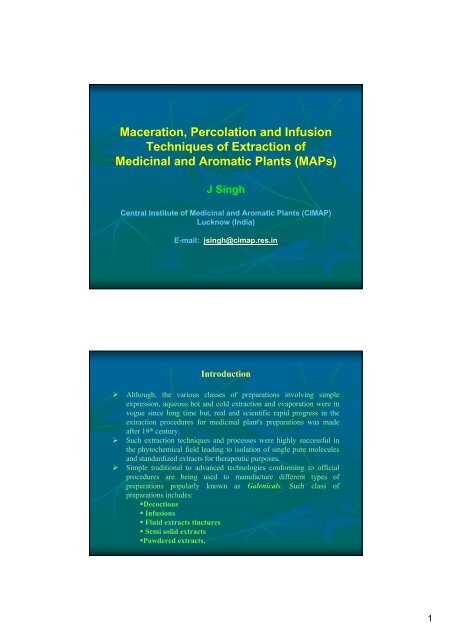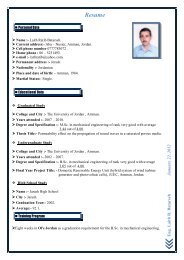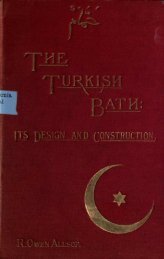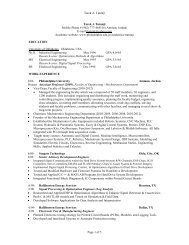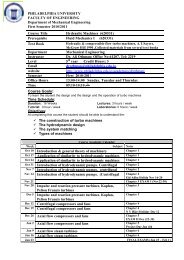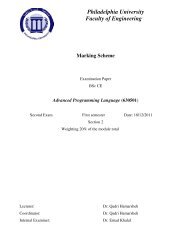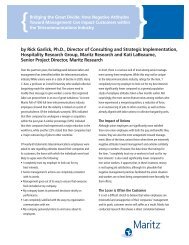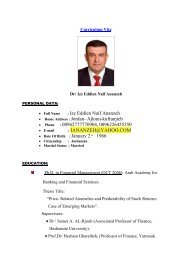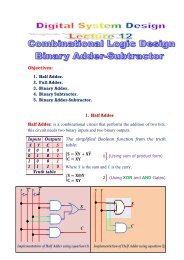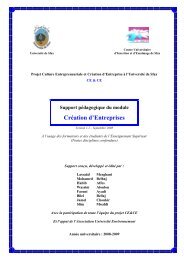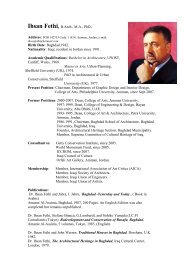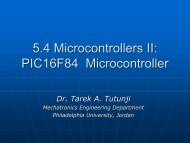Maceration, Percolation and Infusion Techniques of Extraction of ...
Maceration, Percolation and Infusion Techniques of Extraction of ...
Maceration, Percolation and Infusion Techniques of Extraction of ...
You also want an ePaper? Increase the reach of your titles
YUMPU automatically turns print PDFs into web optimized ePapers that Google loves.
<strong>Maceration</strong>, <strong>Percolation</strong> <strong>and</strong> <strong>Infusion</strong><br />
<strong>Techniques</strong> <strong>of</strong> <strong>Extraction</strong> <strong>of</strong><br />
Medicinal <strong>and</strong> Aromatic Plants (MAPs)<br />
J Singh<br />
Central Institute <strong>of</strong> Medicinal <strong>and</strong> Aromatic Plants (CIMAP)<br />
Lucknow (India)<br />
E-mail: jsingh@cimap.res.in<br />
Introduction<br />
Although, the various classes <strong>of</strong> preparations involving simple<br />
expression, aqueous hot <strong>and</strong> cold extraction <strong>and</strong> evaporation were in<br />
vogue since long time but, real <strong>and</strong> scientific rapid progress in the<br />
extraction procedures for medicinal plant's preparations was made<br />
after 19 th century.<br />
Such extraction techniques <strong>and</strong> processes were highly successful in<br />
the phytochemical field leading to isolation <strong>of</strong> single pure molecules<br />
<strong>and</strong> st<strong>and</strong>ardized extracts for therapeutic purposes.<br />
Simple traditional to advanced technologies conforming to <strong>of</strong>ficial<br />
procedures are being used to manufacture different types <strong>of</strong><br />
preparations popularly known as Galenicals. Such class <strong>of</strong><br />
preparations includes:<br />
Decoctions<br />
<strong>Infusion</strong>s<br />
Fluid extracts tinctures<br />
Semi solid extracts<br />
Powdered extracts.<br />
1
<strong>Maceration</strong>, <strong>Percolation</strong> <strong>and</strong> <strong>Infusion</strong> <strong>Techniques</strong> <strong>of</strong><br />
<strong>Extraction</strong>: A General Consideration<br />
These are the general techniques <strong>and</strong> mostly applied for Galenical<br />
preparations.<br />
The sole purpose <strong>of</strong> such basic extraction procedures for crude<br />
drugs are to obtained the therapeutically desirable portion <strong>and</strong><br />
eliminate the inert material by treatment with a selective solvent<br />
known as the Menstruum.<br />
Such types <strong>of</strong> extraction procedures also play a decisive role for the<br />
qualitative <strong>and</strong> quantitative composition <strong>of</strong> the extracts.<br />
The st<strong>and</strong>ardized extracts, thus obtained are further processed for<br />
inclusion in other dosage forms such as Tablets <strong>and</strong> Capsules<br />
containing several groups <strong>of</strong> plant’s metabolites.<br />
These extracts are also utilized for isolation <strong>and</strong> characterization <strong>of</strong><br />
therapeutically active chemical constituents used in modern<br />
medicines.<br />
1. <strong>Maceration</strong> Processes<br />
(Steady – State <strong>Extraction</strong>)<br />
1.1: General Procedure<br />
Plant Material<br />
(Crushed or cut small or<br />
Moderately coarse powder)<br />
Allowed to st<strong>and</strong> for seven<br />
days shaking occasionally<br />
Liquid strained <strong>of</strong>f<br />
Clarified by subsidence<br />
or filtration<br />
Evaporation <strong>and</strong> Concentration<br />
Placed in a closed vessels<br />
Whole <strong>of</strong> the selected solvent<br />
(Menstruum) added<br />
Solid residue (mark) pressed<br />
(Recover as much as<br />
occluded solution)<br />
(Strained <strong>and</strong> expressed<br />
liquids mixed)<br />
2
1.2: <strong>Maceration</strong> Processes for Organized <strong>and</strong> Unorganized Drugs<br />
The processes <strong>of</strong> maceration for organized <strong>and</strong> unorganized drugs are slightly<br />
differ as indicated below:<br />
Processes for Organized Drugs<br />
(e.g e.g. . Barks, Roots)<br />
Process<br />
(i) Drug + whole <strong>of</strong> menstruum<br />
(ii) Shake occasionally during 7 days<br />
(iii) Strain <strong>of</strong> liquid, <strong>and</strong> press the<br />
marc<br />
(iv) Mix the liquid, clarify by<br />
subsidence for filtration<br />
Filtrate is not adjusted to volume<br />
Hence<br />
(a) The direction to press the marc because<br />
there is a considerable proportion <strong>of</strong><br />
liquid adherent to it which could not<br />
otherwise be separated.<br />
(b) The omission <strong>of</strong> directions to adjust to<br />
volume because a variable amount <strong>of</strong><br />
liquid is left in the mark. This liquid<br />
contains soluble matter. If adjustment<br />
to volume were made, a weak product<br />
would result from defective<br />
expression. Omitting adjustment, the<br />
volume <strong>of</strong> liquid expressed<br />
influences the yield <strong>of</strong> product, but<br />
not its strength.<br />
Preparations made by this process -<br />
Vinegar <strong>of</strong> squill, B.P.C<br />
Oxymel <strong>of</strong> Squill, B.P.C<br />
Tincture <strong>of</strong> Orange I.P<br />
Tincture <strong>of</strong> Capsicum, B.P.C<br />
Compound Tincture <strong>of</strong> Gentian<br />
Tincture <strong>of</strong> Lemon<br />
Tincture <strong>of</strong> Squill, B.P.C<br />
Processes for Unorganized Drugs<br />
(e.g. e.g. Gum- Gum resin)<br />
Process<br />
(i) Drug + 4/5ths (in most<br />
cases) <strong>of</strong> menstruum<br />
(ii) ii) Shake occasionally during 2 to 7<br />
days as specified<br />
(iii) iii) Decant the liquid. Marc is not<br />
pressed<br />
(iv) Filter the liquid <strong>and</strong> pass<br />
more menstruum through<br />
filter to volume<br />
Hence<br />
(a) The omission <strong>of</strong> directions to press the marc<br />
because it is neither practicable nor necessary.<br />
(b) The direction to adjust to volume because the<br />
clear upper layer.<br />
(i) Is easily separable by filtration from the lower.<br />
(ii) Contains practically all the soluble matter <strong>of</strong><br />
the drug, the small amount adherent to the<br />
gummy matter being washed therefrom the<br />
menstruum passed through the filter. Hence<br />
adjustment to volume leads to uniformity.<br />
Preparations made by this process –<br />
Compound Tincture <strong>of</strong> Benzoin<br />
Tincture <strong>of</strong> Myrrh, B.P.C<br />
Tincture <strong>of</strong> Tolu, B.P.C<br />
3
1.3: Modifications <strong>of</strong> the General Processes <strong>of</strong> <strong>Maceration</strong><br />
Repeated maceration may be more efficient than a single<br />
maceration, since an appreciable amount <strong>of</strong> active principle may be<br />
left behind in the first pressing <strong>of</strong> the marc.<br />
The repeated maceration is more efficient in cases where active<br />
constituents are more valuable.<br />
Double maceration is used for concentrated infusions which contain<br />
volatile oil, e.g. Concentrated Compound Gentian <strong>Infusion</strong>.<br />
Where the marc cannot be pressed, a process <strong>of</strong> triple maceration is<br />
sometimes employed.<br />
The total volume <strong>of</strong> solvent used is however large <strong>and</strong> the second <strong>and</strong><br />
third macerates are usually mixed <strong>and</strong> evaporated before adding to the<br />
first macerates.<br />
This precludes, the use <strong>of</strong> the process for preparations containing<br />
volatile ingredients.<br />
In a few cases, it is desirable to change the physico – chemical<br />
nature <strong>of</strong> the solvent during a single maceration process.<br />
Opium Tincture is prepared by using change <strong>of</strong> the physicochemical<br />
nature <strong>of</strong> the solvent as indicated below:<br />
First pouring boiling water over the sliced opium to disintegrate it.<br />
Then, after macerating for six hours, 90% alcohols are added to the<br />
cold mixture <strong>and</strong> maceration is continued for a further 24 hours.<br />
The addition <strong>of</strong> the alcohol during the second period <strong>of</strong> maceration<br />
prevents the solution <strong>of</strong> much <strong>of</strong> the gummy material in the final<br />
tincture.<br />
4
1.4: Large Scale <strong>Extraction</strong> Procedures<br />
Large scale operation dem<strong>and</strong>s modification <strong>of</strong> many extraction<br />
processes.<br />
In case <strong>of</strong> jar or vessel containing a small amount <strong>of</strong> solvent (500 to<br />
1000ml) occasional shaking is no problem.<br />
But, for industrial batch where a large amount <strong>of</strong> solvent <strong>and</strong> the<br />
vessels having the huge weight, diameter <strong>and</strong> height, there will be a<br />
considerable difficulty in shaking the vessels.<br />
There are alternative methods <strong>of</strong> agitation that are just as effective<br />
but much simpler to put into practice.<br />
In addition, economics become increasingly important <strong>and</strong> one<br />
<strong>of</strong> the most important objectives is to improve the efficiency <strong>of</strong><br />
extraction so that less solvent is needed <strong>and</strong> evaporation<br />
requirements for concentrated products are reduced.<br />
By reducing the cost <strong>of</strong> evaporation, it has the further advantage <strong>of</strong><br />
minimizing the heat damage to thermo-labile constituents.<br />
1.5: Modified Large Scale <strong>Maceration</strong> Processes<br />
1.5.1: Circulatory <strong>Extraction</strong><br />
The efficiency <strong>of</strong> extraction in a maceration process can be improved<br />
by arranging for the solvent to be continuously circulated through the<br />
drug. as indicated in the Fig., given below.<br />
Solvent is pumped from the bottom <strong>of</strong> the vessel to the inlet where it is<br />
distributed through spray nozzles over the surface <strong>of</strong> the drug.<br />
The movement <strong>of</strong> the solvent reduces boundary layers, <strong>and</strong> the<br />
uniform distribution minimizes local concentration in a shorter time.<br />
Contd.<br />
5
Circulatory <strong>Extraction</strong><br />
1.5.2: Multiple Stage <strong>Extraction</strong><br />
Like the normal maceration process, however, extraction is<br />
incomplete, since mass transfer will cease when equilibrium is set<br />
up. This problem can be overcome by using a multistage process.<br />
The equipment needed for this method is a vessel for the drug,<br />
together with a circulating pump <strong>and</strong> spray distributors, <strong>and</strong> a<br />
number <strong>of</strong> tanks to receive the extracted solution.<br />
The extractor <strong>and</strong> tanks are connected with piping <strong>and</strong> valves as<br />
shown in Fig. so that anyone <strong>of</strong> the tank may be connected to the<br />
extractor for the transfer <strong>of</strong> solution.<br />
Examination <strong>of</strong> these procedures showed that each batch <strong>of</strong> drug is<br />
treated several times with solvent <strong>and</strong> that, once a cycle is in<br />
process, the receivers contain solution with the strongest in receiver<br />
1 <strong>and</strong> the weakest in receiver 3.<br />
6
Advantages:<br />
The drug is extracted as many times as there are receivers – in this<br />
case, three. If more extraction stages are required, it is only<br />
necessary to have more receivers.<br />
The last treatment <strong>of</strong> the drug before it is discharged is with fresh<br />
solvent, giving maximum extraction.<br />
The solution is in contact with fresh drug before removal for<br />
evaporation, giving the highest possible concentration.<br />
Procedure<br />
Fill extractor with drug, add solvent <strong>and</strong> circulate. Run <strong>of</strong>f to receiver 1.<br />
Refill extractor with solvent <strong>and</strong> circulate. Run <strong>of</strong>f to receiver 2.<br />
Refill extractor with solvent <strong>and</strong> circulate. Run <strong>of</strong>f to receiver 3.<br />
Remove drug from extractor <strong>and</strong> recharge. Return solution from 1 to<br />
extractor. Remove for evaporation.<br />
Return solution from 2 to extractor <strong>and</strong> circulate. Run <strong>of</strong>f to receiver 1.<br />
Return solution from 3 to extractor <strong>and</strong> circulate. Run <strong>of</strong>f to receiver 2.<br />
Add fresh solvent to extractor <strong>and</strong> circulate. Run <strong>of</strong>f to receiver 3.<br />
Remove drug from extractor <strong>and</strong> recharge. Repeat cycle.<br />
7
1.5.3: <strong>Extraction</strong> Battery<br />
In the normal percolation process, the percolate is not <strong>of</strong> maximum<br />
concentration <strong>and</strong> as such very dilute.<br />
The ideal situation would be to have maximum concentration.<br />
Continuous extraction devices <strong>of</strong> this type are used where large<br />
amounts <strong>of</strong> single material are h<strong>and</strong>led.<br />
It can be achieved by treating it as a stage wise process.<br />
In this process a series <strong>of</strong> vessels are used <strong>and</strong> extraction is semi –<br />
continuous.<br />
Equipment<br />
Contd.<br />
Equipment is described as an extraction battery <strong>and</strong> consists <strong>of</strong> a<br />
number vessels with inter connecting pipe work.<br />
Vessels are so arranged that solvent can be added to <strong>and</strong> the<br />
product taken from any vessel.<br />
These vessels can, therefore, be made into a series with any <strong>of</strong><br />
vessels as the first <strong>of</strong> the series.<br />
The use <strong>of</strong> extraction battery is illustrated in Fig. given below,<br />
where simplest arrangement <strong>of</strong> three vessel is shown<br />
Contd.<br />
8
2.1: Process<br />
2. <strong>Percolation</strong><br />
(Exhaustive <strong>Extraction</strong>)<br />
Organized vegetable drug in a suitably powdered form.<br />
Uniform moistening <strong>of</strong> the powdered vegetable drugs with menstruum<br />
for a period <strong>of</strong> 4hours in a separable vessel (Imbibition).<br />
Packed evenly into the percolator.<br />
A piece <strong>of</strong> filter paper is placed on surface followed by a layer <strong>of</strong> clean<br />
s<strong>and</strong> so that top layers <strong>of</strong> drugs are not disturbed.<br />
Sufficient menstruum is poured over the drug slowly <strong>and</strong> evenly to<br />
saturate it, keeping the tap at bottom open for passing <strong>of</strong> occluded gas<br />
to pass out.<br />
Contd.<br />
9
Sufficient menstruum is also added to maintain a small layer above the<br />
drug <strong>and</strong> allowed to st<strong>and</strong> for 24 hours.<br />
After maceration, the outlet is opened <strong>and</strong> solvent is percolated at a control<br />
rate with continuous addition <strong>of</strong> fresh volume.<br />
75% <strong>of</strong> the volume <strong>of</strong> the finished product is collected.<br />
Marc is pressed <strong>and</strong> expressed liquid is added to the percolate giving 80%<br />
to 90% <strong>of</strong> the final volume.<br />
Volume is adjusted with calculated quantities <strong>of</strong> fresh menstruum.<br />
Evaporation <strong>and</strong> concentration to get finished products by applying suitable<br />
techniques <strong>and</strong> apparatus<br />
Contd.<br />
10
2.2: Modifications <strong>of</strong> the General Process <strong>of</strong> <strong>Percolation</strong><br />
In general process <strong>of</strong> percolation, particularly in the manufacture <strong>of</strong> concentrated<br />
preparations like liquid extracts, the following problems may arise:<br />
a) If the active substances are thermo-labile, evaporation <strong>of</strong> large volume<br />
<strong>of</strong> dilute percolate, may result in partial loss <strong>of</strong> the active constituents.<br />
b) In the case <strong>of</strong> alcohol- water mixture, evaporation results in preferential<br />
vaporization <strong>of</strong> alcohol leaving behind an almost aqueous concentrate<br />
which may not be able to retain the extracted matter in solution<br />
<strong>and</strong> hence get precipitated.<br />
In such cases the modification in general process <strong>of</strong> percolation is required as<br />
given below:<br />
2.2.1: Reserved <strong>Percolation</strong><br />
In this case the extraction is done through the general<br />
percolation procedure.<br />
At the last, the evaporation is done under reduced pressure<br />
in equipment like a Climbing evaporator to the consistency<br />
<strong>of</strong> a s<strong>of</strong>t extract (semi solid) such that all the water is<br />
removed.<br />
This is then dissolved in the reserved portion which is<br />
strongly alcoholic <strong>and</strong> easily dissolves the evaporated portion<br />
with any risk <strong>of</strong> precipitation.<br />
11
2.2.2: Cover <strong>and</strong> Run Down Method<br />
This is the process which combines the maceration <strong>and</strong> percolation<br />
techniques.<br />
This process can not be used for the materials which contain<br />
volatile principles or those that undergo change during the<br />
evaporation stage.<br />
This procedure is advantageous because industrial methylated spirit<br />
may be used for extraction instead <strong>of</strong> the costly rectified spirit.<br />
The detailed procedure is as follows:<br />
After the imbibition stage the material is packed in a percolator.<br />
Macerated for few hours with suitable diluted industrial methylated<br />
spirit.<br />
Contd.<br />
The liquid is run <strong>of</strong>f <strong>and</strong> the bed is covered with more <strong>of</strong> the<br />
menstruum.<br />
Macerated as before <strong>and</strong> the second volume <strong>of</strong> the extract is<br />
collected.<br />
This process is repeated several times with the later weaker extracts<br />
used for extraction <strong>of</strong> a fresh batch <strong>of</strong> the drug.<br />
More concentrate fractions are evaporated under reduced pressure<br />
to free from the toxic methanol.<br />
Concentrate is diluted with water <strong>and</strong> ethanol to produce correct<br />
concentration <strong>of</strong> alcohol <strong>and</strong> active principle.<br />
12
2.3: Percolators<br />
Different types <strong>of</strong> percolators are used for small <strong>and</strong> large scale extraction<br />
2.3.1: Small scale or laboratory scale extraction<br />
The processes for the manufacture <strong>of</strong> concentrated preparations by<br />
maceration <strong>and</strong> percolations are involved in extraction followed by the<br />
evaporation <strong>of</strong> solvents. The two operations are combined in continuous<br />
extraction process.<br />
(A) Soxhlet Apparatus<br />
On the laboratory scale, the apparatus consists <strong>of</strong> a flask, a<br />
soxhlet extractor <strong>and</strong> a reflux condenser.<br />
The raw material is usually placed in a thimble made <strong>of</strong> filter<br />
paper <strong>and</strong> inserted into the wide central tube <strong>of</strong> the extractor.<br />
Alternatively the drug, after imbibition with the menstruum may<br />
be packed into the extractor taking care to see that the bottom outlet<br />
for the extract is not blocked.<br />
Solvent is placed in the flask <strong>and</strong> brought to its boiling point.<br />
Contd.<br />
Its vapour passes up the larger right h<strong>and</strong> tube into the upper part <strong>of</strong><br />
the drug <strong>and</strong> then to the condenser where it condenses <strong>and</strong> drops<br />
back on to the drug.<br />
During its percolation, it extracts the soluble constituents.<br />
When the level <strong>of</strong> the extracts reaches the top level <strong>of</strong> syphon tube,<br />
the whole <strong>of</strong> the percolates syphon over into the flask.<br />
The process is continued until the drug is completely extracted <strong>and</strong> the<br />
extract in the flask is then processed.<br />
This extraction is series <strong>of</strong> short maceration.<br />
Contd.<br />
13
(B) Official extractor (BP, IP etc.)<br />
Such type <strong>of</strong> extraction are described in the <strong>of</strong>ficial monographs (BP, IP etc.) <strong>and</strong><br />
illustrated in figure given below:<br />
In such cases, the extraction is a continuous percolation extraction<br />
procedure.<br />
In this apparatus, vapour rises through the extraction chamber passing the<br />
drug container; the vapour condenses in the reflux condenser <strong>and</strong> returns<br />
through the drug taking the soluble constituents to the flask.<br />
The limitations <strong>of</strong> this process are:<br />
It is not useful when the raw materials contain thermo-labile active<br />
constituents because the extraction is carried out at an elevated<br />
temperature, <strong>and</strong> the extract in the flask is also maintained in the<br />
hot condition until the process is complete.<br />
It can be used only with pure solvents or with solvent mixtures<br />
forming azeotropes.<br />
If an ordinary binary mixture is used as the menstruum, the<br />
composition <strong>of</strong> the vapour will be different from the liquid<br />
composition.<br />
Contd.<br />
14
Apparatus For Continuous <strong>Extraction</strong> Of Drugs<br />
Similar methods can be used in large scale production:<br />
A typical industrial continuous extraction is shown in fig. given below in<br />
which the principle <strong>of</strong> operation resemble the laboratory equipments<br />
15
2.3.2: Large Scale Extractor<br />
The figure given below shows a type <strong>of</strong> percolator used in the<br />
industrial scale.<br />
The drug is supported on a perforated metal plate covered with a<br />
layer <strong>of</strong> sacking or straw.<br />
The percolator is provided with a removable lid which contains<br />
portholes for packing the drug, for running in the solvent <strong>and</strong> for<br />
observing the flow <strong>of</strong> solvent.<br />
The outlet from the percolator is fitted with a tap <strong>and</strong> pipe line to<br />
remove the percolate for subsequent processing or to use it as a<br />
menstruum for the second percolator in series for more efficient<br />
use <strong>of</strong> the menstruum by carrying out the extraction in a<br />
countercurrent manner.<br />
On a small scale copper percolators were originally used but<br />
these are now largely replaced with percolators made <strong>of</strong> glass<br />
or stainless steel.<br />
Contd.<br />
16
3.1: General Consideration<br />
3. <strong>Infusion</strong><br />
<strong>Infusion</strong>s are dilute solutions containing the readily-soluble<br />
constituents <strong>of</strong> crude drugs.<br />
Formerly, fresh infusions, prepared by macerating the drug for a<br />
short period in cold water or boiling water were used.<br />
Now, infusions are usually prepared by diluting one volume <strong>of</strong> a<br />
concentrated infusion to ten volumes with water.<br />
Concentrated infusions are prepared by modified percolation or<br />
maceration process, which after dilution with water, resemble in<br />
potency <strong>and</strong> aroma the corresponding fresh infusion.<br />
<strong>Infusion</strong>s are liable to fungus <strong>and</strong> bacterial growth, <strong>and</strong> it is<br />
necessary to dispense them within twelve hours <strong>of</strong> their preparation.<br />
3.2: General method for preparing fresh infusion<br />
The drug is usually coarsely powdered, very fine powder being<br />
avoided (50 gm).<br />
Moisten the drug in a suitable vessel, provided with a cover, with<br />
50 ml <strong>of</strong> cold water.<br />
Allow to st<strong>and</strong> for 15 minutes.<br />
Then add 900 ml <strong>of</strong> boiling water, cover the vessel tightly.<br />
Allow it to st<strong>and</strong> for 30 minutes.<br />
Then strain the mixture, pass enough water to make the infusion<br />
measure 1000 ml<br />
Some drugs are supplied in accurately weighed in muslin bags for<br />
preparing specific amounts <strong>of</strong> infusion.<br />
If the activity <strong>of</strong> the infusion is affected by the temperature <strong>of</strong><br />
boiling water, cold water should be used.<br />
As the fresh infusions do not keep well, they should be made<br />
extemporaneously <strong>and</strong> in small quantities.<br />
17
3.3: Preparation <strong>of</strong> Concentrated <strong>Infusion</strong>s<br />
The <strong>of</strong>ficial monographs also recognize certain “concentrated<br />
infusions” in which 25% alcohol is added during or<br />
subsequent to the infusion process.<br />
Concentrated infusions are especially prepared in which the<br />
active <strong>and</strong> desirable principles <strong>of</strong> drug are equally soluble in<br />
water or in the menstruum used for both concentrate <strong>and</strong><br />
infusions.<br />
4. Evaporations<br />
One <strong>of</strong> the quality- relevant parameter is the evaporation <strong>of</strong> the<br />
eluate to the s<strong>of</strong>t extract.<br />
The state <strong>of</strong> art are cautious vacuum evaporation apparatus<br />
<strong>and</strong> evaporation temperatures not exceeding 55 0 C.<br />
The temperature in correlation with the evaporation time is <strong>of</strong><br />
special importance for quality <strong>of</strong> this step <strong>of</strong> manufacture, if the<br />
extract contains easily volatile or thermo- labile constituents.<br />
18
5. Factors Affecting Choice <strong>of</strong> <strong>Extraction</strong> Process<br />
The final choice <strong>of</strong> the process to be used for the extraction <strong>of</strong> a<br />
drug will depend on a number <strong>of</strong> factors, including:<br />
5.1: Character <strong>of</strong> Drug<br />
If hard <strong>and</strong> tough (such as nux vomica) use percolation.<br />
If s<strong>of</strong>t <strong>and</strong> parenchymatous (such as gentian) use maceration.<br />
If ‘unpowderable’ (such as squill) use maceration.<br />
If an ‘unorganized drug (such as benzoin) use maceration.<br />
If preferable to avoid powdering (such as senna fruits) use<br />
maceration.<br />
Thus, knowledge <strong>of</strong> the pharmacognosy <strong>of</strong> the drug is<br />
essential to selection <strong>of</strong> the extraction process that will give<br />
the best result.s<br />
Contd.<br />
5.2: Therapeutic value <strong>of</strong> the drug<br />
When the drug has considerable therapeutic value, the maximum<br />
extraction is required, so that percolation is used, as in belladonna. If<br />
the drug has little therapeutic value, however, the efficiency <strong>of</strong><br />
extraction is unimportant <strong>and</strong> maceration is adequate; for example,<br />
“flavours” (lemon), or “bitters”, (gentian).<br />
5.3: Stability <strong>of</strong> drug<br />
Continuous extraction should be avoided when the constituents <strong>of</strong> the<br />
drug are thermo-labile.<br />
19
5.4: Cost <strong>of</strong> drug<br />
From the economic point <strong>of</strong> view, it is desirable to obtain complete<br />
extraction <strong>of</strong> an expensive drug, so that percolation should be<br />
used; Ginger is an example <strong>of</strong> this type.<br />
For cheap drugs, the reduced efficiency <strong>of</strong> maceration is<br />
acceptable in view <strong>of</strong> the lower cost <strong>of</strong> the process. In particular,<br />
the cost <strong>of</strong> size reduction to a powdered state is avoided, whereas<br />
this is a significant part <strong>of</strong> the percolation process.<br />
5.5: Solvent<br />
If the desired constituents dem<strong>and</strong> a solvent other than a pure<br />
boiling solvent or an azeotrope, continuous extraction should be<br />
used.<br />
5.6: Concentration <strong>of</strong> product<br />
Dilute products such as tincture can be made by maceration or<br />
percolation, depending on the previous factors.<br />
For semi-concentrated preparations (concentrated infusions, for e.g.)<br />
the more efficient percolation process is used) unless the drug<br />
cannot be powdered or is not worth powdering, when double or triple<br />
maceration is chosen.<br />
Concentrated preparations, <strong>of</strong> which liquid extracts or dry extracts<br />
are example, are made exclusively by percolation, with the exception<br />
that continuous extraction can be used if the solvent is suitable <strong>and</strong><br />
the constituents are thermo-stable.<br />
5.7: Recovery <strong>of</strong> solvent from the marc<br />
The residue <strong>of</strong> the drug after extraction (<strong>of</strong>ten known as the marc) is<br />
saturated with solvent <strong>and</strong> if economic the latter is recovered.<br />
20
6. Conclusions<br />
The spectrum <strong>of</strong> constituents obtained by steady state<br />
extractions (Simple macerations) differs from the spectrum<br />
obtained by exhaustive extractions (<strong>Percolation</strong>).<br />
By the use <strong>of</strong> motive extraction methods, the aid <strong>of</strong> stirring <strong>and</strong><br />
shearing forces, changes <strong>of</strong> temperature <strong>and</strong> quality <strong>of</strong><br />
extraction solvent may lead to extracts with a spectrum <strong>of</strong><br />
constituents’ similar (equivalent) to one obtained by percolation.<br />
Different manufacturing procedures have to be assessed as<br />
equivalent if the critical quality parameters <strong>of</strong> the specification<br />
are conformed to <strong>and</strong> if compliance with st<strong>and</strong>ards is proven by<br />
the results <strong>of</strong> a number <strong>of</strong> production batches.<br />
21


